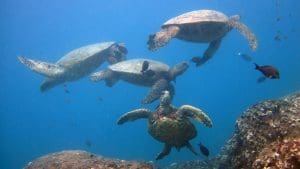Green Sea Turtles

Once, there were tens of millions of green sea turtles around the world.
Now there may be fewer than 200,000 mature females. In Hawaiian waters, the green sea turtle is making a comeback from its threatened status. Due to their size and swiftness in the water, they have only two predators, sharks and people. Human impact includes exploitation, poaching, subsistence hunting, incidental catch, marine debris and habitat destruction.
What you can do, if you find a sick, injured or entangled turtle in Hawaii
Of the three native Hawaiian species, the most common is the green sea turtle.
- This is the largest of the hard-shelled turtles weighing up to 440 pounds and measuring up to 4 feet.
- Hawaii’s green sea turtles reach sexual maturity at around 25 years.
- They can migrate up to 800 miles away from their feeding areas near the coasts of main islands, to nesting beaches in the Northwestern Hawaiian Islands.
- From one to 350 females nest each year, coming to shore several times in one season.
- It will be two to three years before the same female will nest again.
- While each nest averages 100 eggs, only a few of the hatchlings will survive to adulthood.

Green Sea turtles can be colored from dark brown to olive with lighter stripes and spots. Adult shell lengths range in size from 0.9-1.1 meters (36-43 inches) and weights average 90-137 kilograms (200-300 pounds). They are primarily a tropical herbivorous species and the turtle with a serrated jaw. Others turtles native to Hawaii include the hawksbill and leatherback turtle, while loggerheads, and olive and Kemp’s Ridley turtles are infrequent visitors. All of these turtles (except the Green which are threatened) are endangered.
Sea turtles have been known to move through the water as fast as 35 mph. When active, sea turtles swim to the surface every few minutes in order to breathe. When sleeping or resting, which usually occurs at night, adult sea turtles can remain underwater for more than 2 hours without breathing. Juvenile sea turtles have not developed this ability as well as adults and must sleep afloat at the water’s surface.
The green sea turtle, called honu in Hawaii, is featured in mythology, petroglyphs and as aumakua (personal family gods and guardians). The most common sea turtle in Hawaiian waters, can frequently be seen feeding in shallow coastal waters. It takes this turtle almost three decades to reach an adult breeding size of 200 pounds or more. Turtles have been recorded living longer than 100 years, and can reach up to 350 pounds in the wild.
Threats currently facing sea turtles include:
- Destruction of coral reef
- Loss of nesting beaches through human development activities
- Climate change affecting temperatures and gender of hatchlings (warmer weather makes male hatchlings)
- Pollution of the oceans by chemicals and garbage/plastics
- Harvesting of turtles for their shells, leather, and meat
- Poaching of turtle eggs
- Death in driftnets, gillnets, shrimp trawling nets, and other fishing gear
- A mysterious and fatal disease called fibropapilloma, whose cause and cure are still unknown, and which is at epidemic levels in parts of Hawaii and Florida, and other areas of the world.
We found a turtle cleaning station!
From the book Fire in the Turtle House:
The Green Sea Turtle and the Fate of the Ocean, Osha Gray Davidson, an award-winning journalist and personal friend, tells the story of the search for the cause of tumors afflicting marine turtles world-wide, and describes the surprisingly broad implications the disease has for the oceans and ultimately, all of humankind.
Wild Side’s wildlife tours focus on education and conservation so that an interactive relationship can be maintained in the best interest of both humans and dolphins. We strive to foster admiration and deep respect for these wonder-full marine mammals.

